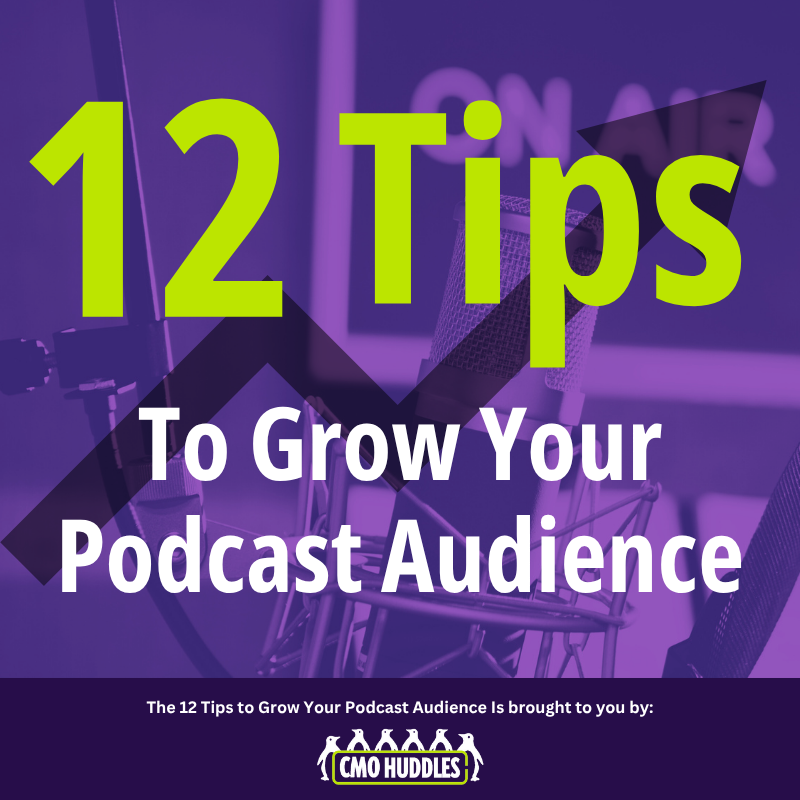If your company has a podcast, at some point, your CEO will ask, "How do we grow the reach of our show?" It’s a familiar request—and a fair one, in theory. Podcasts can be a powerful tool for thought leadership, customer engagement, and even demand generation. But here’s the catch: Most B2B podcasts aren’t designed to go viral, nor should they be.
If you’re in B2B marketing and targeting a niche audience, success isn’t about millions of downloads. It’s about the right audience tuning in consistently—and taking action.
Still, that doesn’t mean your podcast’s reach can’t or shouldn’t grow. It just means you need a smart, strategic, and sustainable approach. What follows is a 12-step guide to doing just that, pulled straight from my own experience building Renegade Marketers Unite and advising dozens of CMOs inside CMO Huddles.
1. Start with the Show Itself
Before trying to scale, take a hard look at the content.
- Is the audio quality crisp and professional?
- Is the editing tight, or are listeners sitting through “ums,” tangents, and filler?
- Are the topics genuinely enlightening—or just comfortable conversations?
Your podcast must be good. Not “good enough.” Not “we have one because everyone else does.” Good.
The biggest lever for reach is quality. No amount of SEO, paid promotion, or clever packaging will save a mediocre show.
2. Audience Quality > Audience Quantity
Repeat after me: Reach is not the same as relevance.
Your CEO may be thinking in terms of raw numbers, but a niche B2B podcast needs only a niche audience. If your ICP is Fortune 500 CMOs, and you’ve got 500 regular listeners who fit that mold, you’re winning.
Renegade Marketers Unite was never built to top the Apple Podcast charts—it was built to serve and reflect the needs of B2B marketing leaders. Every episode, every guest, and every question is tailored to their world.
Reach only matters when you’re reaching the right people.
3. Choose Guests Strategically
This may be the most under-leveraged growth tool in your podcast arsenal.
- Invite influential guests with relevant, active audiences.
- Feature customers to strengthen relationships and create internal advocates.
- Ask guests to share the episode—but make it easy. Send them promo copy, short clips, quote cards, and trackable links.
A well-connected guest can dramatically increase your reach—especially if their company promotes the episode internally and externally.
4. Differentiate or Die
Let’s be honest: The world does not need another generic “B2B marketing podcast.”
You must carve out a distinct niche. Maybe it’s focused on a specific industry (e.g., cybersecurity), a narrow persona (e.g., CFOs at startups), or a unique format (e.g., short-form lessons, behind-the-scenes case studies, Pecha Kucha-style interviews).
Take a page from Jeff Morgan at Elements, who created a podcast just for dentists. At the time, no one else was doing it, and that gave the show a massive head start.
5. Commit to Consistency
Podcast audiences are creatures of habit. If you publish sporadically or skip weeks, they’ll drift.
- Set a publishing cadence (ideally weekly).
- Keep the episode length consistent.
- Drop new episodes the same day and time each week.
Consistency builds trust—and trust builds audience.
6. Turn One Episode into Dozens of Assets
You didn’t just create a podcast—you created a content engine. Use it.
- Extract 90-second video clips for LinkedIn, YouTube Shorts, or Instagram.
- Turn standout quotes into social graphics.
- Write a recap blog post or newsletter summary.
- Use soundbites to energize sales enablement and internal comms.
This is how you turn one 30-minute episode into 15+ pieces of content that expand your reach exponentially.
7. Create a Promotional Flywheel
Each episode should be accompanied by a multi-pronged promotional plan. Here’s a checklist to maximize visibility:
Before the Episode Launch:
- Share teaser quotes or clips to build anticipation
- Email your internal teams to get early support
Day of Launch:
- Email episode to your database (segment where relevant)
- Publish a LinkedIn post from the host and guest
- Publish to your website and optimize for SEO
- Post to your social channels (LinkedIn, Twitter, YouTube, etc.)
- Put the entire show transcript on your website
Post-Launch (1–2 Weeks After):
- Reshare key clips as shorts or reels
- Turn into a blog or newsletter spotlight
- Encourage employee advocacy with ready-to-share snippets
- Boost top-performing clips via paid LinkedIn/Meta
- Include episode in future nurture sequences or onboarding
8. Simplify Your Production Workflow
One of the biggest barriers to podcast growth is burnout. If your process takes 20 hours per episode, you’ll stop publishing. Guaranteed.
Our secret weapon? Descript. It’s an all-in-one AI tool for:
- Recording
- Editing
- Transcribing
- Creating video clips
- Generating audiograms
- Writing social copy
By centralizing production, you can spend less time editing and more time promoting.
9. Test, Learn, Repeat
Some experiments will fail. That’s okay.
Try:
- Different headline structures (curiosity vs. value-based)
- Guest formats (solo, panel, customer stories)
- Episode durations (10-min vs. 30-min)
- Distribution channels (YouTube, Spotify, LinkedIn, Substack)
Track what actually works—downloads, listens, shares, comments—and refine from there.
10. Redefine the Value of "Reach"
Let’s say your podcast has 800 monthly listeners. That may sound modest—until you discover those listeners include your best prospects, customers, and influencers.
Now ask yourself: Would you be happy speaking in front of 800 members of your target audience every single month? Most executives would jump at the opportunity.
Also consider the internal value:
- Educating sales teams on customer pain points
- Equipping execs with thought leadership soundbites
- Celebrating customer wins
- Codifying your company’s point of view
In this light, podcasting isn’t just a marketing channel—it’s a strategic asset with outsized value in the right hands.
11. Be a Guest on Other Podcasts
This might be the most overlooked growth lever of all. Appearing on other shows that target a similar audience is a tried-and-true way to expand your reach—and build credibility by association.
But remember: being a good guest requires just as much preparation as being a good host. The best guests are spontaneous and succinct. That means:
- Keeping your answers short and pithy
- Letting the host shine
- Staying conversational (this isn’t a TED Talk)
- Delivering value without sounding like a commercial
If done right, guesting on other shows can introduce your voice—and by extension, your podcast—to new, highly relevant listeners. It also reinforces your POV and builds long-tail discoverability across podcast platforms.
12. Aim for Broadcast Quality
Every day you’re on camera with peers, employees, partners, and customers. And every day you’re representing your company brand and your personal brand. Here are five tips to ensure your presence reinforces your credibility—not undermines it.
Recommended Equipment
- Camera: Logitech Brio ($169 on Amazon)
- Lighting: Desk Lamp E7 with Clamp ($79 from Uplift)
- Microphone: Heil Sound PR 40 ($249 on Amazon) + Tascam Ministudio US-42B pre-amp ($44 on Amazon)
Tip #1: Invest in an external camera
Built-in laptop cameras are limited. External webcams like the Logitech Brio offer better lens quality, wider framing, and 4k resolution.
Tip #2: Fix your lighting
Avoid backlighting. Either rotate your setup or add a front-facing light. Adjustable LED desk lamps work great. (Skip ring lights if you wear glasses.)
Tip #3: Upgrade your audio
Use a high-quality mic like the Heil PR 40. Condenser mics reduce ambient noise and give your voice a richer presence.
Tip #4: Assess your background
Natural settings are best. If you must use a virtual background, keep it simple and ensure your lighting keeps you in clear view.
Tip #5: Get more bandwidth
Aim for at least 100 Mbps download / 25 Mbps upload. Ideally 400 Mbps for best streaming quality.
Your "on camera" presence is part of your brand. Treat it like it matters—because it does.

